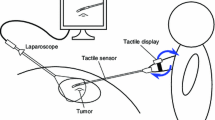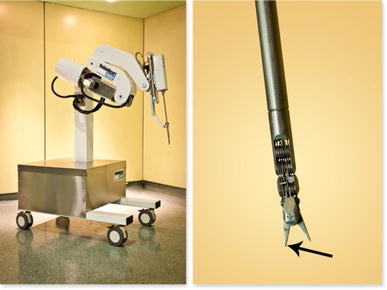Abstract
Purpose:
In current minimally invasive surgery techniques, the tactile information available to the surgeon is limited. Improving tactile sensation could enhance the operability of surgical instruments. Considering surgical applications, requirements such as having electrical safety, a simple structure, and sterilization capability should be considered. The current study sought to develop a grasper that can measure grasping force at the tip, based on a previously proposed tactile sensing method using acoustic reflection. This method can satisfy the requirements for surgical applications because it has no electrical element within the part that is inserted into the patient’s body.
Methods:
We integrated our acoustic tactile sensing method into a conventional grasping forceps instrument. We designed the instrument so that acoustic cavities within a grasping arm and a fork sleeve were connected by a small cavity in a pivoting joint. In this design, when the angle between the two grasping arms changes during grasping, the total length and local curvature of the acoustic cavity remain unchanged. Thus, the grasping force can be measured regardless of the orientation of the grasping arm.
Results:
We developed a prototype sensorized grasper based on our proposed design. Fundamental tests revealed that sensor output increased with increasing contact force applied to the grasping arm, and the angle of the grasping arm did not significantly affect the sensor output. Moreover, the results of a grasping test, in which objects with different softness characteristics were held by the grasper, revealed that the grasping force could be appropriately adjusted to handle different objects on the basis of sensor output.
Conclusions:
Experimental results demonstrated that the prototype grasper can measure grasping force, enabling safe and stable grasping.








Similar content being viewed by others
References
Semere W, Kitagawa M, Okamura AM (2004) Teleoperation with sensor/actuator asymmetry: task performance with partial force feedback. In: Proceedings of the IEEE international symposium on haptic interfaces for virtual environment and teleoperator systems. doi:10.1109/HAPTIC.2004.1287186
Wagner CR, Stylopoulos N, Howe RD (2002) The role of force feedback in surgery: analysis of blunt dissection. In: Proceedings of the IEEE symposium on haptic interfaces for virtual environment and teleoperator systems. doi:10.1109/HAPTIC.2002.998943
Braun EU, Mayer H, Knoll A, Lange R, Bauernschmitt R (2008) The must-have in robotic heart surgery: haptic feedback. In: Bozovic V (ed) Medical robotics. I-Tech Education and Publishing, Rijeka, pp 9–20
Puangmali P, Althoefer K, Seneviratne LD, Murphy D, Dasgupta P (2008) State-of-the-art in force and tactile sensing for minimally invasive surgery. IEEE Sens J 8(4):371–381
King CH, Culjat MO, Franco ML, Bisley JW, Carman GP, Dutson EP, Grundfest WS (2009) A multielement tactile feedback system for robot-assisted minimally invasive surgery. IEEE Trans Haptics 2(1):52–56
Kuwana K, Nakai A, Masamune K, Dohi T (2013): A grasping forceps with a triaxial MEMS tactile sensor for quantification of stresses on organs. In: Proceedings of the international conference of the IEEE engineering in medicine and biology society, pp 4490–4493
Valdastri P, Harada K, Menciassi A, Beccai L, Stefanini C, Fujie M, Dario P (2006) Integration of a miniaturised triaxial force sensor in a minimally invasive surgical tool. IEEE Trans Biomed Eng 53(11):2397–2400
Dargahi J, Parameswaran M, Payandeh S (2000) A micromachined piezoelectric tactile sensor for an endoscopic grasper—theory, fabrication and experiments. J Microelectromech Syst 9:329–335
Qasaimeh MA, Sokhanvar S, Dargahi J, Kahrizi M (2009) PVDF-based microfabricated tactile sensor for minimally invasive surgery. J Microelectromech Syst 18(1):195–207
Sokhanvar S, Packirisamy M, Dargahi J (2007) A multifunctional PVDF-based tactile sensor for minimally invasive surgery. Smart Mater Struct 16:989–998
Hong MB, Jo YH (2012) Design and evaluation of 2-DOF compliant forceps with force-sensing capability for minimally invasive robot surgery. IEEE Trans Robot 28(4):932–941
Seibold U, Kuebler B, Hirzinger G (2008) Prototypic force feedback instrument for minimally invasive robotic surgery. In: Bozovic V (ed) Medical robotics. I-Tech Education and Publishing, Rijeka, pp 377–400
Hagn U, Konietschke R, Tobergte A, Nickl M, Jorg S, Kuebler B, Passig G, Groger M, Frohlich F, Seibold U, Le-Tien L, Albu- Schaffer A, Nothhelfer A, Hacker F, Grebenstein M, Hirzinger G (2010) DLR MiroSurge: a versatile system for research in endoscopic telesurgery. Int J CARS 5(2):183–193
Kim U, Lee DL, Yoon WJ, Hannaford B, Choi HR (2015) Force sensor integrated surgical forceps for minimally invasive robotic surgery. IEEE Trans Robot 31(5):1214–1224
Trejos AL, Patel RV, Naish MD, Lyle AC, Schlachta CM (2009) A sensorized instrument for skills assessment and training in minimally invasive surgery. J Med Devices 3(4):041002
Arata J, Mitsuishi M, Warisawa S, Tanaka K, Yoshizawa T, Hashizume M (2005) Development of a dexterous minimally invasive surgical system with augmented force feedback capability. In: Proceedings of the IEEE/RSJ international conference on intelligent robots and systems, pp 3738–3743
Son HI, Bhattacharjee T, Lee DY (2010) Estimation of environmental force for the haptic interface of robotic surgery. Int J Med Robot Comput Assist Surg 6(2):221–230
Tadano K, Kawashima K (2009) Development of a pneumatically driven forceps manipulator IBIS IV. In: Proceedings of ICROS-SICE international joint conference, pp 3815–3818
Takaki T, Omasa Y, Ishii I, Kawahara T, Okajima M (2010) Force visualization mechanism using a moire fringe applied to endoscopic surgical instruments. In: Proceedings of the IEEE international conference on robotics and automation, pp 3648–3653
Faragasso A, Stilli A, Bimbo J, Noh Y, Liu H, Nanayakkara T, Dasgupta P, Wurdemann HA, Althoefer K (2014) Endoscopic add-on stiffness probe for real-time soft surface characterisation in MIS. In: Proceedings of the international conference of the IEEE engineering in medicine and biology society, pp 6517–6520
Li J, Liu H, Althoefer K, Seneviratne LD (2012) A stiffness probe based on force and vision sensing for soft tissue diagnosis. In: Proceedings of the international conference of the IEEE engineering in medicine and biology society, pp 944–947
Watanabe T, Iwai T, Fujihira Y, Koyama T, Yoneyama T (2016) Stiffness measurement system using endoscopes with a visualization method. IEEE Sens J 16(15):5889–5897
Kawahara T, Kaneko M (2005) Non-contact stiffness imager for medical application. In: Proceedings of the IEEE international conference on information acquisition, pp 350–355
Puangmali P, Liu H, Seneviratne LD, Dasgupta P, Althoefer K (2012) Miniature 3-axis distal force sensor for minimally invasive surgical palpation. IEEE ASME Trans Mechatron 17(4):646–656
Tanaka Y, Fukuda T, Fujiwara M, Sano A (2015) Tactile sensor using acoustic reflection for lump detection in laparoscopic surgery. Int J CARS 10(2):183–193
Fukuda T, Tanaka Y, Fujiwara M, Sano A (2015) Softness measurement by forceps-type tactile sensor using acoustic reflection. In: Proceedings of the IEEE/RSJ international conference on intelligent robots and systems, pp 3791–3796
Figliola RS, Beasley DE (2011) Theory and design for mechanical measurements, 5th edn. Wiley, New York
Rosen J, Brown JD, De S, Sinanan M, Hannaford B (2008) Biomechanical properties of abdominal organs in vivo and postmortem under compression loads. J Biomech Eng 130(2):021020
Tanaka Y, Aragaki S, Fukuda T, Fujiwara M, Sano A (2014) A study on tactile display for haptic sensing system with sensory feedback for laparoscopic surgery. In: Proceedings of the international symposium on micro-nanomechatronics and human science. doi:10.1109/MHS.2014.7006169
Author information
Authors and Affiliations
Corresponding author
Ethics declarations
Conflict of interest
The authors declare that they have no conflict of interest.
Ethical approval
This article does not contain any studies with human participants performed by any of the authors.
Informed consent
This article does not contain patient data.
Rights and permissions
About this article
Cite this article
Ly, H.H., Tanaka, Y., Fukuda, T. et al. Grasper having tactile sensing function using acoustic reflection for laparoscopic surgery. Int J CARS 12, 1333–1343 (2017). https://doi.org/10.1007/s11548-017-1592-7
Received:
Accepted:
Published:
Issue Date:
DOI: https://doi.org/10.1007/s11548-017-1592-7




